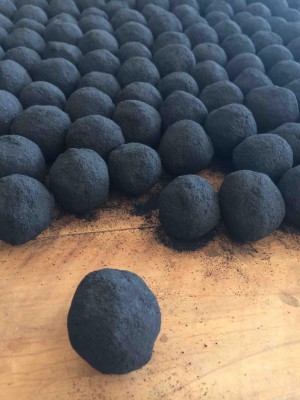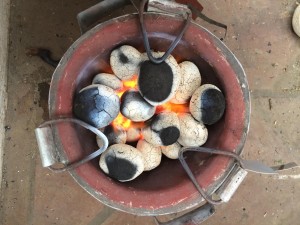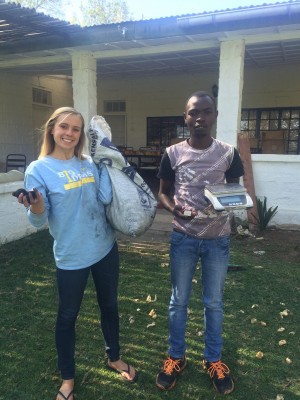By Sybil Lewis
Sanitation and the removal of human waste are among the biggest environmental health issues of our time. According to UNICEF and the World Health Organization, 70 percent of the population in Sub-Saharan Africa lacks access to adequate sanitation—and in Kenya, sanitation coverage is available to only 41 percent of the country, largely because the government cannot afford or is not incentivized to cover the high costs of building pipes and sewage treatment plants in low-income areas. This leads to open defecation, fecal contaminated water, and disease.
To deal with this crisis, many non-governmental organizations are trying to come up with affordable and sustainable toilet solutions. One UC Berkeley student team and Big Ideas@Berkeley winner has been working in Kenya not just to increase sanitation services but to turn human waste into an energy solution—what they call “turning poo to power.”
Appropriately named Feces to Fuel, the four-member Cal team has been collaborating with Sanivation, a UC Berkeley- and Kenya-based organization that provides in-home toilets and waste collection services. Feces to Fuel’s plan is to collect fecal waste from Sanivation’s facility in Naivasha, Kenya and turn it into charcoal briquettes that can be sold at an affordable price and used as cooking oil.

According to Catherine Berner, a UC Berkeley graduate and member of the Feces to Fuel team, the creation of charcoal briquettes addresses another major issue affecting low-income populations in Kenya and throughout East Africa—the financial, environmental, and health costs associated with using traditional forms of cooking oil.
Berner, who majored in Environmental Engineering Science, explains that in many semi-urban and urban communities in Kenya the only available and affordable fuel sources are wood and charcoal, which have become increasingly unaffordable. Over the past decade, energy prices in Kenya have increased five-fold, and in Naivasha families are spending over 30 percent of their income on cooking fuel, hindering their ability to move out of poverty. Furthermore, burning crude forms of energy produces hazardous gasses, which are harmful not only to the environment but lead to serious health problems—more than half the deaths of children worldwide under age five are due to inhaling household air pollution.
Sanivation and Feces to Fuel have combined these seemingly unrelated problems to create a solution that both improves sanitation services and provides affordable fuel for low-income families.
But the enterprise is still very young. Sanivation launched its sanitation services in only September 2014. From its facilities in Naivasha, the social enterprise has been installing free in-home toilets, called Blue Boxes, for a $7 monthly subscription that includes twice weekly waste collection. In its first four months of operation, Sanivation signed up 57 customers for its in-home toilet and has maintained a 98 percent re-subscription rate. It aims to reach a million users by 2020.
Also over the past year, Sanivation has expanded its business model to turn the collected waste into energy, which is where Feces to Fuel comes in. Feces to Fuel is helping Sanivation identify and implement the best technology and method to transform human waste into a reliable fuel source. The project—which includes Cal students Emily Woods, Ken Lim, and Fiona Gutierrez-Dewar—is funded largely by an $8,000 prize from the 2015 Big Ideas@Berkeley competition in the Clean & Sustainable Energy Alternatives category.

“Before collaborating with Feces to Fuel, Sanivation was using solar concentrators to heat up the feces because their original plan was to turn waste into fertilizer, yet people were asking if they could use it to cook food,” said Berner. “Sanivation replied no because it was not safe yet, but what they realized is that there is a huge need for fuel created from treated feces.”
Andrew Foote and Emily Woods, the founders of Sanivation who developed their model while undergraduate students at Georgia Institute of Technology, said they have spent the past four years trying to figure out a reliable method of sanitizing feces using solar energy. Woods is now a PhD student in the Energy and Resources Group at UC Berkeley and Foote works fulltime on Sanivation.
In 2014, Sanivation started to develop a process that combines two waste forms—agricultural and human—to produce biomass-based briquettes for use in household stoves. The team now collects rose waste from surrounding flower farms, which otherwise would be burnt or discarded, and carbonizes the waste to create an energy dense charcoal dust. The rose waste biomass is then combined with human feces, collected from Sanivation’s in-home toilets, and heated up with solar concentrators to inactivate all pathogens, rendering the feces safe for use. The mixture of rose waste and feces is then placed in a machine, which turns the mixture into small briquettes.
According to Berner, the briquettes sold in Kenya are usually made with local organic waste or charcoal dust from traditional charcoal with trash-slurry as the binder. This combination produces little energy and lots of smoke, making it difficult to compete with charcoal. Whereas the energy-dense rose waste and high calorific value of feces used by Sanivation and Feces to Fuel produces briquettes that emit less smoke and burn longer than traditional biomass briquettes.

“Around the world and specifically in Sub-Saharan Africa, a lot of people are working on carbonizing agricultural waste into fuel and reusing feces for fuel,” said Woods. “We are carbonizing rose waste and using feces as the binder, which has never been done before.”
Other feces-to-fuel efforts have turned human waste into biogas, biodiesel, and fertilizer. Notable examples include the feces-biogas powered bus in the U.K and bio centers in Kenyan slums, which turn feces into biogas to power public showers. No other method, however, has used human feces to make briquettes for cooking.
While the number of feces-to-fuel innovations is growing, there is still a lack of research on the composition of feces and its potential for fuel. To develop its model, Sanivation relied on the work of few research organizations, such as the Swiss Federal Institute of Aquatic Science and Technology (Eawag).
“I think that there is little research on the composition of feces, largely because of social stigma,” Berner said. “Human waste is just seen as that, waste, and not as a resource. For our model to work, we must find and show the value of waste.”
Sanivation conducted a beta test in mid 2014, in which 2,000 kg of briquettes were tested by families in Naivasha and the Kakuma refugee camp, along with small businesses and some industrial settings, to determine the best markets. Feedback from the beta test showed high customer satisfaction with the quality of the fuel; it also revealed that people are not uncomfortable with the idea of cooking with materials made with human feces. This is attributable to the fact that the briquettes do not look or smell like feces, said Berner.
Further analysis from the beta test showed that small businesses, such as hospitals and schools, are the key group for Sanivation to target, because they can provide consistent, mid-size orders, said Berner. However, Sanivation plans to continue working on sanitation in refugee camps in East Africa. The social enterprise received funding from the CDC’s Innovation Fund to design a system in the Kakuma Refugee Camp on the Kenya-South Sudan border. As part of the pilot for the toilet implementation, 30 families in the refugee camp tested their briquettes over a period of eight weeks.
During the summer of 2015, Feces to Fuel focused on improving the quality and manufacturing capability of the briquettes. In Naivasha, Woods, Berner, and Gutierrez-Dewar, implemented the Adam Retort, a carbonizer with high-energy efficiency and low pollution, which has been producing over 300 kgs of charcoal dust per week, according to Berner. The Berkeley team also helped Sanivation build out their waste treatment site and a greenhouse to study the potential of making fuel from dry waste.

Meanwhile in the U.S., Ken Lim, a UC Berkeley junior and member of the Feces to Fuel team, conducted research at MIT with experts in the briquette and charcoal field. Sanivation’s feces treatment method had already been proven to be safe for human use by the Center for Disease Control and Prevention; Lim’s role at MIT was to conduct more research to understand the composition of feces and its potential for fuel. The team is currently conducting further research on its briquettes at the Chemisense lab.
One of Sanivation’s main aspirations is to improve environmental health. If its briquettes can be sold at 60 percent the cost of charcoal, Woods said they will reduce the demand for traditional charcoal, offsetting the industry’s environmental impact that has left Kenya with 5 percent of its historic forest cover and contributed to climate change.
“We estimate that each ton of our briquettes saves 88 trees from deforestation,” said Berner. “Briquetting is taking off in Kenya. If we are able to prove our model, it will bring more attention to the briquetting industry and help replace the large demand for unsustainable charcoal.”